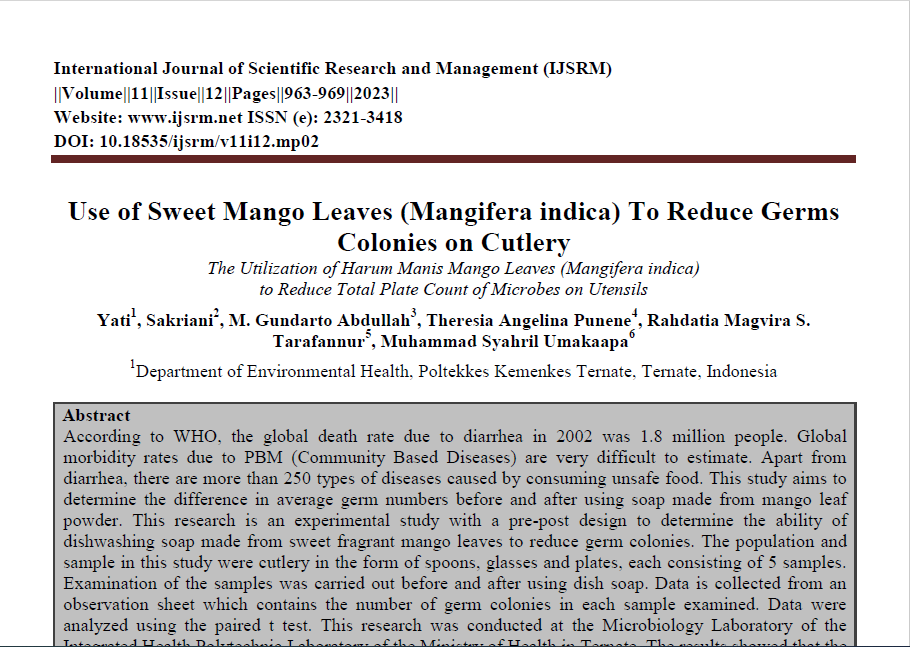
Submission to VIJ 2023-12-10
Keywords
- Mango Leaves,
- Germs Colonies,
- Cutlery
Copyright (c) 2023 Yati, Sakriani, M. Gundarto Abdullah Anwar, Theresia Angelina Punene Nurlaeli, Rahdatia Magvira S. Tarafannur, Muhammad Syahril Umakaapa

This work is licensed under a Creative Commons Attribution 4.0 International License.
Abstract
According to WHO, the global death rate due to diarrhea in 2002 was 1.8 million people. Global morbidity rates due to PBM (Community Based Diseases) are very difficult to estimate. Apart from diarrhea, there are more than 250 types of diseases caused by consuming unsafe food. This study aims to determine the difference in average germ numbers before and after using soap made from mango leaf powder. This research is an experimental study with a pre-post design to determine the ability of dishwashing soap made from sweet fragrant mango leaves to reduce germ colonies. The population and sample in this study were cutlery in the form of spoons, glasses and plates, each consisting of 5 samples. Examination of the samples was carried out before and after using dish soap. Data is collected from an observation sheet which contains the number of germ colonies in each sample examined. Data were analyzed using the paired t test. This research was conducted at the Microbiology Laboratory of the Integrated Health Polytechnic Laboratory of the Ministry of Health in Ternate. The results showed that the average germ number in the pre-test was 2454.44 ± 668.70, while in the post-test the average germ number was 1178.67 ± 249.61. The P value = 0.012 (< 0.05) indicates that there is a significant difference in the average number of germs before and after using soap made from mango leaf powder. The conclusion is that using soap made from mango leaf powder can significantly reduce the number of germs on the hands. This shows the potential of soap as an effective alternative in maintaining cleanliness and reducing the risk of spreading disease through hand contact.
References
- Aditya Cahya Nugraha, et al. / Indonesian Journal of Chemical Science 6 (2) (2017)
- Anonymous, 2011b. E.coli on cutlery. http://libfkmui.wordpress.com, accessed March 1, 2011.
- Anonymous, 2011c. Tableware. http://repository.usu.ac.id, accessed 01
- Chandra, B., 2006. Introduction to environmental health. Medical book. EGC. Jakarta.
- Cushnie, TPTim. Lamb, Andrew J. Amtimicrobial Activity of Flavonoids. International Journal of Antimicrobial AgentsI. 2005;26:343-356.
- http://journal.unnes.ac.id/sju/index.php/ijcs
- https://pasche08.files.wordpress.com/2009/05/copy-of-copy-of-makalah quercetin-2003.pdf
- Republic of Indonesia Ministry of Health, 2003. Republic of Indonesia Minister of Health Decree No. 715/Menkes/SK/V/2003 Concerning Sanitation Hygiene Requirements for Jasaboga, Jakarta.
- Republic of Indonesia Ministry of Health. Principles of Food Sanitation Hygiene. Jakarta : Director General of PPM & PLP, 1999.
- Ifka W. Kobis, Jootje MLUmboh, Victor Pijoh. 2013. Description of the presence of Escherichia coli on tableware in the Bersehati Market restaurant, Manado City. Faculty of Public Health, Sam Ratulangi University, Manado.
- Jilfer Poli, Henry Palandeng, J. Sinolunga. 2013. The relationship between the behavior of food handlers and the number of germs on eating utensils in food stalls in the Malalayang beach area, Manado City.
- journal.uin-alauddin.ac.id › index.php › psb › article › download by Y Yasir 2015
- Journal of Research Chemistry, Volume 2 No. 1, June 2017
- JH Doughari and S. Manzara, “In Vitro Antibacterial Activity of Crude Leaf Extracts of Mangifera indica Linn,” African Journal of Microbiology ... 2, 2008, pp.
- Ministry of Agriculture. 2012. Food Consumption Statistics 2012. Jakarta: Center for Agricultural Data and Information Systems, Ministry of Agriculture
- Li, H. Wang, Z. Liu, Y. Review in the studies on tannins activity of cancer prevention and anticancer. Zhong-Yao-Cai. 2003; 26(6): 444-448.
- Madduluri, Suresh. Rao, K. Babu. Sitaram, B. In Vitro Evaluation of Antibacterial Activity of Five Indegenous Plants Extract Against Five Bacterial Pathogens of Human. International Journal of Pharmacy and Pharmaceutical Sciences.2013:5(4): 679-684.
- Masibo, M. & Q. He. 2009. In Vitro Antimicrobial Activity and the Major Polyphenol in Leaf Extract of Mangifera indica L. Malaysian Journal of Microbiology, 5(2): 73-80
- Mustapha, Alqasim Abdullahi., Enemali, MO, d Olose, M., Owuna, G., Ogaji, JO, Idris, MM, and Aboh, VO, 2014, Phytoconstituents and Antibacterial Efficacy of Mango (Mangifera indica) Leave Extracts, Journal of Medicinal Plant Studies 2 (5): 19-23.
- Nuria, Maulita Cut, Faizaitun, Arvin, Sumantri, Test of the Antibacterial Activity of Ethanol Extract of Jatropha Curcas L Leaves Against the Bacteria Staphylococcus Aureus Atcc 25923, Escherichia Coli Atcc 25922, and Salmonella Typhi Atcc 1408, Mediagro.2009;5(2) :26–37.
- Republic of Indonesia. Law No. 36 of 2009 concerning Health. Jakarta : Republic of Indonesia State Gazette 2009 No. 144. State Secretariat, 2009.
- Samosir, Ainun. 2011. Relationship between the behavior of handlers making pliek in home industries and the presence of the Aspergillus Niger fungus in Darul Imarah District, Aceh Besar in 2011.
- Sari, FP and SM Sari. Extraction of Antimicrobial Active Substances from Iodine Plants (Jatropha multifida Linn) as Alternative Raw Materials for Natural Antibiotics. Semarang: Faculty of Engineering, Diponegoro University. 2011
- Tumelap HJ Bacteriological Condition of Cutlery at the Jombang Tikala Manado Restaurant. Manado: Department of Environmental Health, Ministry of Health, Manado, 2011, Vol. Volume 1 no.1 October 2011.